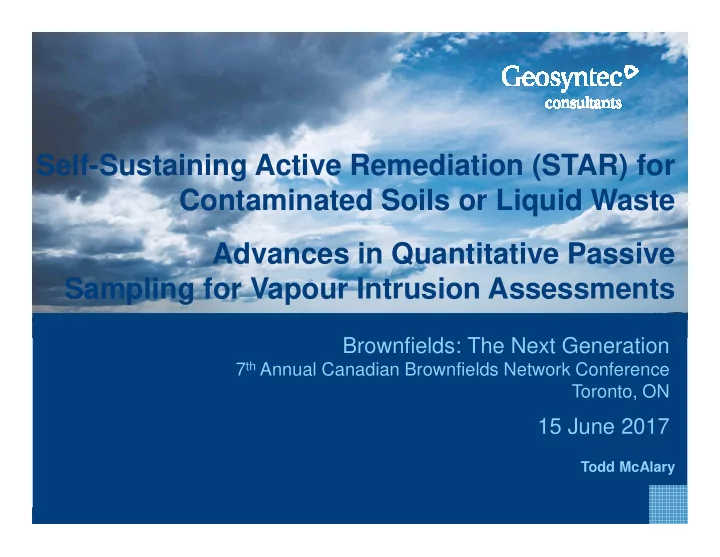

Self-Sustaining Active Remediation (STAR) for Contaminated Soils or Liquid Waste Advances in Quantitative Passive Sampling for Vapour Intrusion Assessments Brownfields: The Next Generation 7 th Annual Canadian Brownfields Network Conference Toronto, ON 15 June 2017 Todd McAlary
Smoldering Combustion STAR and STARx are based on the process of smoldering combustion: Contaminated Soil or Waste Exothermic reaction converting carbon Product compounds to CO 2 + H 2 O Fuel Injected Combustion Air Heater Element (for ignition only) Heat Oxidant smoldering possible due to large surface area of organic liquids 2 (e.g., NAPL) within the presence of a porous matrix (e.g., aquifer)
Modes of Application • In situ (below water table) • Ex situ (above ground) • Applied via wells in portable • Soil piles placed on “Hottpad” in-well heaters system • Range of contaminants: • Highly effective and controlled applications • Petroleum Hydrocarbons • Ideal for: • Coal tar • Excavated contaminated soils • Creosote and sediments • High volatility • Waste oils / tank bottom compounds require fuel residuals surrogate • Lagoon sludge 3
STAR – In Situ Systems 4
STARx – “Hottpad” Systems 5
Case Study - Site Overview • 37-acre former manufacturing facility in Newark, New Jersey Passaic River PSE&G • Coal tar associated with Site former waste lagoons (now in-filled) • 55,000 CY impacted soils: • Shallow fill (0-10 ft bgs) Ashland Chemical Co • Deep Sand (~10-40 ft bgs) Diamond Alkali 6
STAR Case Study • Two target layers: – Shallow Fill – Deep Sand • Shallow Fill: – 1700 wells – 20-well Cells – 10’ separation Node • Deep Sand: (max distance to Treatment Point – 300 wells power source) – 6-well Cells – 20’ separation • Operation organized by: – Well – Cell (groups of Wells Cell operated simultaneously) (Group of Treatment Points – Node (groups of Cells treated at the same time) serviced by single system deployment) 7
Full-scale System Recuperative Thermal Oxidizer Extracted Vapors to RTO Well head connection Vacuum Extraction Air Injection for Well Points In well Heater Treatment Trailer
Full-scale Results Example Cell: 3-D-03 ~10,000kg of coal tar destroyed (via 6 wells) in approximately 10 Before days 100,000 Safe Working Hours After
Full-scale Hottpad – Field Deployment 10
Background • Designed for 3,500 m 3 of API separator sludge • Petroleum hydrocarbon-impacted soils 11
Full-scale Hottpad - Results After Before 12
Conventional Active Soil Gas Sampling
M Passive Sampling C 0 = UR t × The mass (M) and time (t) are measured accurately. The key is to know the uptake rate (UR). UR has units of mL/min
Starvation In soil and under building slabs, air flow is low, and may produce the “starvation effect” when collecting passive samples, leading to negative bias. Starvation occurs when the uptake rate of the sampler is higher than the delivery rate of analytes to the sampler; the sampler will “scrub” its environment, causing a low concentration bias.
Mathematical Modeling What would we expect for the diffusive delivery rate (DDR)?
Steady-State Model Total Porosity 37.5% (note scale is semi-logarithmic)
Lower the Uptake Rate Decrease area of sampling surface Increase membrane thickness
100,000,000 Concentration in Waterlooo Membrane Sampler Uptake rate about 1 mL/min Uptake rate about 0.2 mL/min 10,000,000 1,000,000 (µg/m 3 ) 100,000 10,000 1,000 1,000 10,000 100,000 1,000,000 10,000,000 100,000,000 Concentration in Active Sampler (µg/m 3 )
Another Use for Passive Samplers: Long-term Indoor Air Sampling
Results 1:1 line ---- 50% RPD 21
Summary • Passive sampling for soil gas sampling has many advantages over active sampling • ease of use • reproducibility (simple protocols, less inter-operator error) • time-weighted average smooths temporal variability • Starvation can be mathematically described, and passive samplers designed to minimize the starvation effect • This innovation was awarded a US patent (#9399912) in 2016 • Waterloo Membrane Samplers can be used for • quantitative passive soil vapour sampling • long-term indoor air sampling • Passive sampling is accepted in the MOECC vapour intrusion guidance
More Information Geosyntec, 2011. Demonstration of Improved Assessment Strategies for Vapor Intrusion - Passive Samplers. SPAWAR Systems Center Pacific. Geosyntec, 2014. Development of More Cost-Effective Methods for Long-term Monitoring of Soil Vapor Intrusion to Indoor Air Using Quantitative Passive Diffusive-Adsorptive Sampling. ESTCP Project ER-200830, June 2014. McAlary, T., X. Wang, A. Unger, H. Groenevelt, T. Gorecki, 2014. Quantitative passive soil vapor sampling for VOCs - part 1: theory. Environ. Sci.: Processes Impacts, 2014, 16, 482. DOI: 10.1039/c3em00652b. McAlary, T., H. Groenevelt, S. Seethapathy, P. Sacco, D. Crump, M. Tuday, B. Schumacher, H. Hayes, P. Johnson, T. Gorecki, 2014. Quantitative passive soil vapor sampling for VOCs - part 2: laboratory experiments. Environ. Sci.: Processes Impacts, 2014, 16, 491. DOI: 10.1039/c3em00128h. McAlary, T., H. Groenevelt, P. Nicholson, S. Seethapathy, P. Sacco, D. Crump, M. Tuday, H. Hayes, B. Schumacher, P. Johnson, T. Gorecki, I. Rivera- Duarte, 2014. Quantitative passive soil vapor sampling for VOCs - part 3: field experiments. Environ. Sci.: Processes Impacts, 2014, 16, 501. DOI: 10.1039/c3em00653k. McAlary, T., H. Groenevelt, S. Seethapathy, P. Sacco, D. Crump, M. Tuday, B. Schumacher, H. Hayes, P. Johnson, L. Parker, T. Gorecki, 2014. Quantitative passive soil vapor sampling for VOCs - part 4: flow-through cell. Environ. Sci.: Processes Impacts, 2014, 16, 1103. DOI: 10.1039/c4em00098f. McAlary, T., H. Groenevelt, S. Disher, J. Arnold, S. Seethapathy, P. Sacco, D. Crump, B. Schumacher, H. Hayes, P. Johnson, T. Gorecki, 2015 . Passive sampling for volatile organic compounds in indoor air-controlled laboratory comparison of four sampler types. Environ. Sci.: Processes Impacts, 2015, 17, 896. DOI: 10.1039/c4em00560k. Seethapathy, S. and T. Gorecki, 2010. Polydimethylsiloxane-based permeation passive air sampler. Part II: Effect of temperature and humidity on the calibration constants. J. Chromatog. A, 2010, 1217, Issue 50, 7907. http://dx.doi.org/10.1016/j.chroma.2010.10.057. Seethapathy, S. and T. Gorecki, 2011. Polydimethylsiloxane-based permeation passive air sampler. Part I: Calibration constants and their relation to retention indices of the analytes. J. Chromatog. A, 2011, 1218, Issue 1, 143. http://dx.doi.org/10.1016/j.chroma.2010.11.003.
Recommend
More recommend